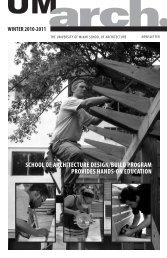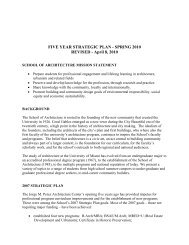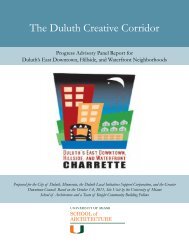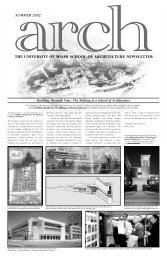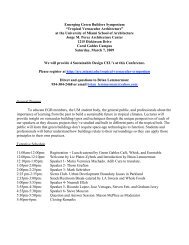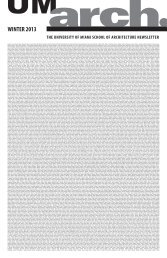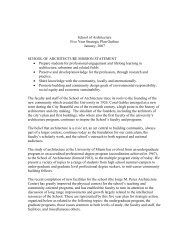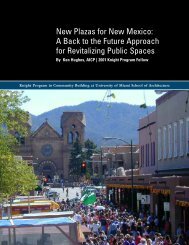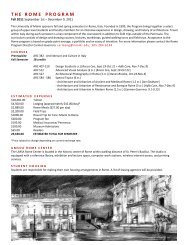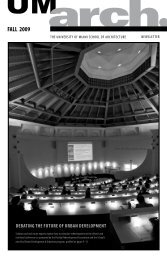Full Report - Knight Program in Community Building
Full Report - Knight Program in Community Building
Full Report - Knight Program in Community Building
You also want an ePaper? Increase the reach of your titles
YUMPU automatically turns print PDFs into web optimized ePapers that Google loves.
2The Public Process and New UrbanismBy Jennifer Hurley | 2001 <strong>Knight</strong> <strong>Program</strong> FellowBioJennifer Hurley is a partnerwith Hurley Franks andAssociates, a plann<strong>in</strong>g andurban design firm <strong>in</strong>Philadelphia, Pennsylvania.AbstractThe phrase “public process” refers to a variety of situations related to public<strong>in</strong>volvement <strong>in</strong> plann<strong>in</strong>g and development decisions: public hear<strong>in</strong>gs with plann<strong>in</strong>gcommissions, zon<strong>in</strong>g boards, and city councils; citizen task forces; and urbandesign charrettes. The public process as applied by New Urbanists offers greatbenefits and also presents some difficult problems. This report discusses whatNew Urbanists can learn from specialists <strong>in</strong> public participation and alternativedispute resolution, and what New Urbanists have to teach those same specialists.What Can Charrette Practitioners Learn from Consensus-Build<strong>in</strong>g?By learn<strong>in</strong>g from the experience of mediators and facilitators, charrette organizerscan leverage the event to create more support for the results, ultimatelylead<strong>in</strong>g to more faithful implementation.• A robust theoretical basis for practice can <strong>in</strong>form the understand<strong>in</strong>g of theprocess and suggest possibilities when problems arise.A close relationship between theory-build<strong>in</strong>g and practice development canenrich both. S<strong>in</strong>ce academics have shown little <strong>in</strong>terest <strong>in</strong> charrette practice,practitioners should educate themselves about relevant theories, articulatehow theory can improve practice, and illum<strong>in</strong>ate the holes <strong>in</strong> theory thatpractice uncovers.• Situat<strong>in</strong>g the charrette event <strong>in</strong> a larger decision-mak<strong>in</strong>g framework that<strong>in</strong>cludes pre-charrette outreach and post-charrette consensus-build<strong>in</strong>g<strong>in</strong>creases the chances of implementation.Make sure a community is ready for a collaborative process like a charrette.Include considerations of politics and community organiz<strong>in</strong>g <strong>in</strong> the def<strong>in</strong>itionof “ready.” Make sure key stakeholders will participate. Be clear about therules of engagement, the decision-mak<strong>in</strong>g process and the role of the public.Especially <strong>in</strong> situations with high levels of conflict, make sure the keystakeholders agree with the scope and focus of the charrette.• Us<strong>in</strong>g the charrette to aid group learn<strong>in</strong>g and build<strong>in</strong>g civic capital will leveragethe event to develop local leaders who can champion the plan long afterthe event.Document the stakeholder <strong>in</strong>put. Make notes from stakeholder meet<strong>in</strong>gs,and make those notes available <strong>in</strong> the charrette report or on a project website. Demonstrate how public comment <strong>in</strong>fluenced the products.





